Before the industrial revolution, Norwich was England's second city. growing rick on income from the wool and fabric trade. Worsted is named after a village to the north of the city, and it was that cloth that really made the area rich. Merchants built houses, mansions, warehouses and then there were the churches.
The city was crammed with churches, my Grandfather used to say there was a church for each week of the year, and a pub for each day. Not sure if that is true, but I can confirm that in places churches are virtually next to each other, and one street had 5 churches alone. And the churches were built of the local stone; or flint in this case, so are dark but sparkle. Knappers shaped the flints to fabulous shapes, to create works of art.
East Anglia is lacking in the raw materials for the industrial revolution, so the 19th century passed it by, but the medieval street, buildings, houses and churches survived. And so is a glorious legacy for the city. But the sheer number of churches of historical importance is also a millstone; so many to upkeep and repair, and some fell by the wayside. And as the city's people became less religious, many were no longer needed, so fell into disrepair, or were used for other things. And in doing so, some became closed to the public, and so were dark shadows on the side of the city streets.
I have many friends who were frustrated at not being able to see inside any more, and then out of the blue when I was in Norfolk before Christmas, I was reading the EDP and saw that there was a church festival being planned. I made a note of the date, and once I found their website, I kept looking, and once all the details was confirmed, Jools and I booked two nights in a hotel, and so were going to make a weekend out of it. For a change, I had planned the day out very much like a military operation. I downloaded the guide, and annotated the map showing all the churches with opening times, so had a route marked out, with the churches opening from 8 in the morning. Jools wasn't going to walk round the city for eight hours, instead she was going to a bead shop near to Ely again, meaning I could indulge myself fully. And maybe have a pint or two of ale during the day too.
Which is what I was laying in a bed in Norwich, staring at an unfamiliar ceiling at just before six on a bright Saturday morning. Birds had been singing outside the window for nearly two hours, and I could hear bells ringing over the city as the hour was marked.
We got up and showered, and were down in the breakfast room dead on half seven, as we both wanted to get on with our days. There was musli followed by a fry up and then toast and jams. And coffee. We filled our boots, even if the scrambled eggs came fried instead. Just as well maybe.....
Jools left in the car at quarter past eight, and I soon followed on foot, walking along to the railway station, cutting through the forecourt and over the main road before crossing the River Wensum on the new footbridge. Oddly, I was followed by a tame squirrel for a while, and he was still behind me as I crossed the quiet lane and into the passageway leading to St Julian's.
St Julian was a famous anchorite who lived in the 14th century, and locked herself away in a cell beside the church, and over her life became a mystic and theologian, writing the first book in English by a woman.
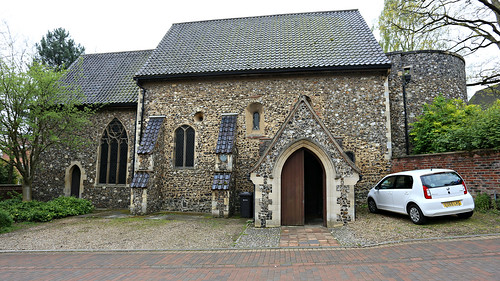 The church where she lived was near to the hotel, and being the first to open that day, it was my port of call. Like many city churches, it is found among houses, although in this case, modern, and one of the main roads to the old cattle market runs a few yards away, but at half eight on a Saturday morning, it was calm and peaceful, and I had the church to myself. I guess I was disappointed that her cell has long since gone, and been replaced by a small chapel. Only to be expected I suppose, but I had found a church in Kent a few months back that still had the squint in the wall from an anchorite cell, though the identity of who lived there was not known.
The church where she lived was near to the hotel, and being the first to open that day, it was my port of call. Like many city churches, it is found among houses, although in this case, modern, and one of the main roads to the old cattle market runs a few yards away, but at half eight on a Saturday morning, it was calm and peaceful, and I had the church to myself. I guess I was disappointed that her cell has long since gone, and been replaced by a small chapel. Only to be expected I suppose, but I had found a church in Kent a few months back that still had the squint in the wall from an anchorite cell, though the identity of who lived there was not known.After getting my shots, I check my map, and decide that the next church, St John Timberhill. St John I had passed hundreds of times, but in recent years, maybe I was just unlucky, but never found it unlocked, but as promised it was open when I arrived on the stroke of nine, after climbing up Rouen Road and then crossing the main road.
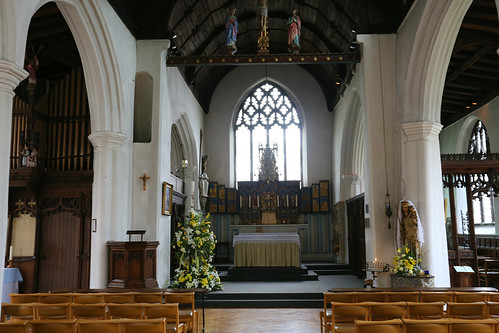 The church now nestles in a corner of Castle Mall at the top of Timber Hill, and ancient cobbled street. Opposite its entrance, there are upmarket furniture shops and fashion stores, and on the other side fo Cattle Market Street, the Woolpack pub sits, where back in the 80s, I used to have lunch with Mum and Dad before going to the football.
The church now nestles in a corner of Castle Mall at the top of Timber Hill, and ancient cobbled street. Opposite its entrance, there are upmarket furniture shops and fashion stores, and on the other side fo Cattle Market Street, the Woolpack pub sits, where back in the 80s, I used to have lunch with Mum and Dad before going to the football.I meet a man coming out of the church, he had slept inside that night and asked me for money. He held out his dirty hand, and I wondered what his life story was, how someone can end up like this. Maybe the failure of care in the community, I don't know. I give him a pound, and he pushes for another, but I need change for offerings at each of the churches I plan to visit. He leaves, and I have the church to myself again.
I would have liked to stay and take in the church, but the clock was ticking, so after getting the shots again, I consult the map and St Michael at Plea opened at nine, and was just a short walk away through Tombland. I check St George and St Peter Hungate on the way, and were both still locked.
St Michael is now a bookshop and Christian Resource centre, which explains where vicars and priests get their shirts and candles from. There isn't much to see, but I take a couple of shots inside, and of the monuments on the wall. And can move on.
Down Wensum Street and past the Ribs of Beef on the junction of Colegate stands St Clement the Martyr. I have also walked past this many, many times, and wondered what was inside. But nothing was to prepare me for what I found, as the church is now home to the Guild of Stonemasons, and inside the church has been converted to a ramshackle collection of offices and work areas, and a library. There are also displays of stonework on show too. Also visiting was a side of Morris Dances, and their jingling bells could be heard if they even moved their arm, so walking was like being surrounded by Christmas Elves.
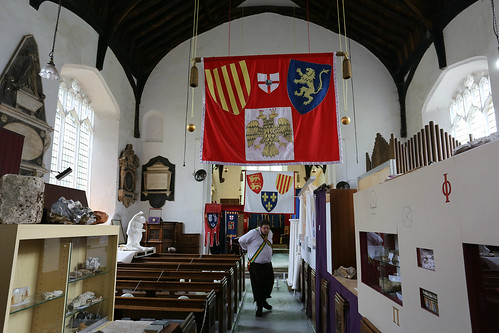 Again, it was hard to snap details, but also with colourful banners hanging down and a large paier mache dragons head on display, it was memorable.
Again, it was hard to snap details, but also with colourful banners hanging down and a large paier mache dragons head on display, it was memorable.I go to the coffee shop offpiste to recharge with caffeine, and to check the map. There was a round route could go to take in some of the outer lying churches, so with the route planned, I set off down unfamiliar lanes and streets, twisting and turning.
St Martin at Oak lies down a quiet street now, but in the past was next to a huge shoe factory, which is now being converted in an arts centre, or so it seemed to me. Anyway, St Martin is now a music academy, and previously had been a hostel for homeless people, so has undergone major reworking since it was a church. But it is till covered in memorials, and was manned by two very knowledgeable volunteers who delighted in taking me to the rear half of the church which is usually out of bounds. We talk for a while, but in truth, with the clock ticking I was thinking about my next target, St Augustine.
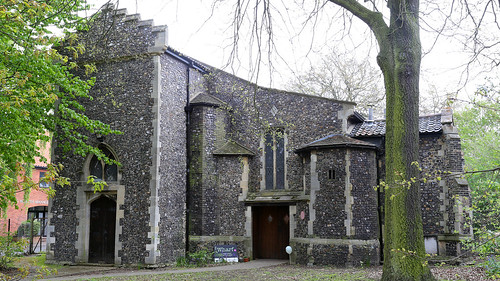 St Augustine was a good ten minute hike away, over the inner ringroad and then up another main road. It was so far out, it wasn't on the map, just indicated its existence by an arrow and the legend: here be dragons. Not really.
St Augustine was a good ten minute hike away, over the inner ringroad and then up another main road. It was so far out, it wasn't on the map, just indicated its existence by an arrow and the legend: here be dragons. Not really.It was quite a chunk out of the day to get here, so hoped it would be worth it, but when I arrived, I found both doors locked and no sign of life. I was disappointed, but there was a sign saying a key could be obtained opposite, so I go to the opticians, and ask, and was given the key.
 Back in the church, all was quiet and cool, as outside the traffic jumped.
Back in the church, all was quiet and cool, as outside the traffic jumped. I retraced my steps to the ringroad, then through the subway to the other side, taking a shortcut through a warren of lanes and passages, ending up at Magdalen Street for my next target, St Saviours.
It is now a theatre, and once inside it is easy to forget its origins, but then all around are memorials still on the wall. I am welcomed by the volunteers, and indeed meet the person who arranged the whole event, and is very happy to learn I came from Dover just to attend the event.
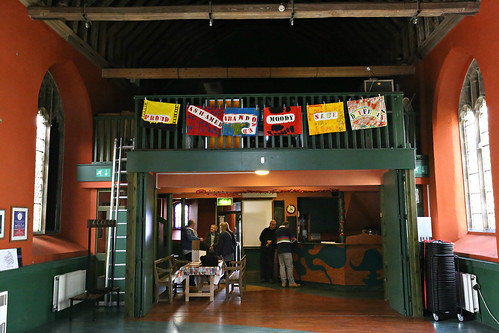 From now on, most of the churches would be close together, so I could really start racking up those numbers. And shots.
From now on, most of the churches would be close together, so I could really start racking up those numbers. And shots.A ten minute walk away, and back towards the Cathedral, is St George Tombland. Another one I had passed many times, and one I had been itching to see inside. On the way I see St Peter is open too, so it was all coming together.
Inside St George, it was packed, as a guided tour was just leaving, so I could listen in for all the interesting parts of the church were described. There were banners, another paier mache dragon, and a St George too, and yet more great people who were only too happy to help out and answer questions.
 Yes, it was now getting near to midday, and my feet were getting a little sore, but there was more to do before I could stop, so I walk back up Princes Street back to St Peter Hungate, which, yes, I had also walked past many times. Not sure what to expect, but inside it was a clear space, with information boards all the way round telling the history of the building.
Yes, it was now getting near to midday, and my feet were getting a little sore, but there was more to do before I could stop, so I walk back up Princes Street back to St Peter Hungate, which, yes, I had also walked past many times. Not sure what to expect, but inside it was a clear space, with information boards all the way round telling the history of the building.

No comments:
Post a Comment